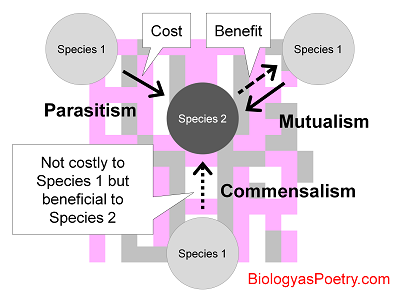∞ generated and posted on 2016.08.29 ∞
Long-term interaction between two organisms where "long-term" is defined in generations for at least one of the organisms and the interaction is physically intimate.
Often the symbiosis will consist of one organisms, the symbiont, living either on or inside of the other organism (the host). Symbioses can be classified in terms of the location of symbiont as well as in terms of the impact of the symbiont on the host. Thus, there are parasitic, mutualistic, or commensal symbioses in which the host is either harmed, helped, or neither harmed nor helped by the symbiosis, respectively (the symbiont, on the other hand, usually is helped by the interaction). We can also speak of such things as ectoparasites, which live on the outside of their hosts, and endosymbionts which live inside of cells.

Figure legend: Interspecific interactions giving rise to different categories of symbioses. In all cases Species 2 benefits from the interaction. In a mutualism, Species 1 also benefits (and hence the arrow pointing its way). In parasitism, there is a cost to Species 1 stemming from the relationship (as indicated) and no or insufficient benefits to make up for the cost. In a commensalism the benefits gained by Species 2 on a whole do not result in costs to Species 1.
Pathogens are an example of parasitic symbionts whereas the cell "organelles" called mitochondria and chloroplasts are mutualistic endosymbionts. The human body possess approximately 100 symbionts, mostly commensals, for every actual human body cell, making up what is known as the human microbiome. In fact, the typical human carries around approximately 1014 – one-hundred trillion – mostly bacterial symbionts which live predominantly in the lumens of our colons. Normal internal body tissues in a non-disease state, on the other hand, tend to be sterile save for our own cells along with those microorganisms (mitochondria, but also endogenous retroviruses) that are normal inhabitants of our cells.